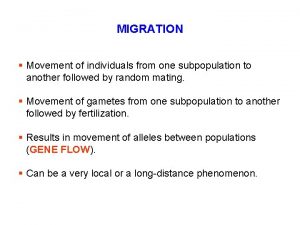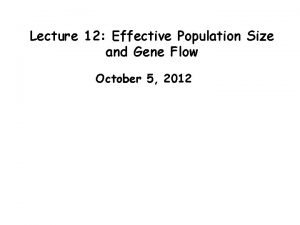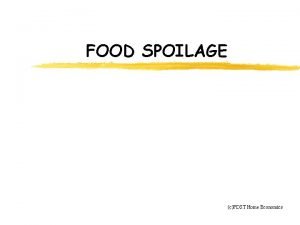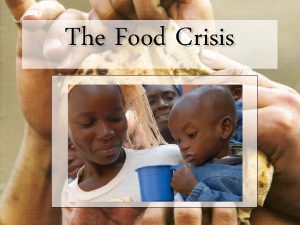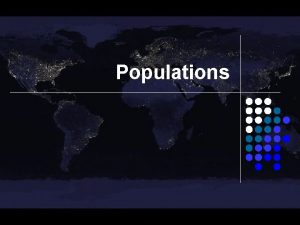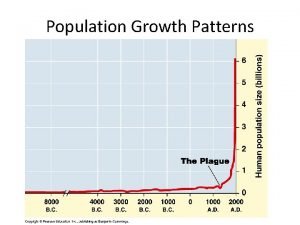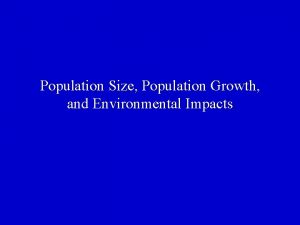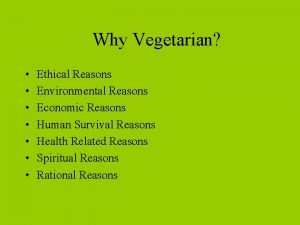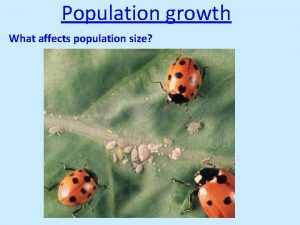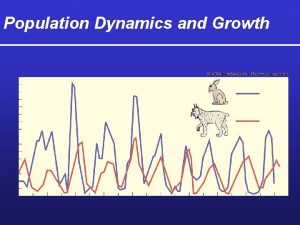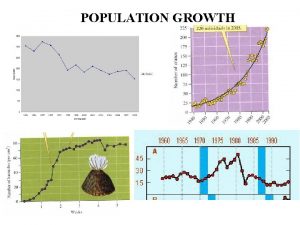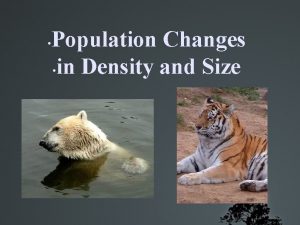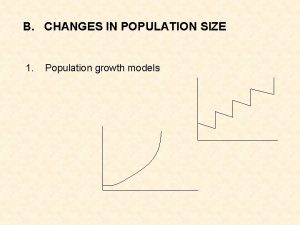Reasons for Food Crisis Food Crisis Population size
























- Slides: 24

Reasons for Food Crisis

Food Crisis Population size and growth Some countries are having trouble matching food production to their population growth (reasons for this are given in the next few slides). Malthus of course predicted this, although the massive starvation and death did not happen on a global scale due to the following reasons: a) b) c) New areas of agriculture were opened up – prairies in N. A. , Australia and South Africa – mainly due to irrigation. Science and technology - Green revolution and GMO’s (Genetically Modified Organisms). Some crops grew faster, yielded more and were disease resistant. Better transportation and storage. Reduced waste and allowed movement from deficit areas to surplus areas, especially for emergency food aid.

Reasons For Food Crisis 1. Low level of agricultural technology Agricultural activities can be classified in TWO ways. The first (A) can classify farming as either Subsistence or Cash-Cropping: A 1. Subsistence Farming – Farmers that grow crops and raise livestock for their own use. Grow enough to keep them and their families alive. A 2. Cash-Crop Farming – Farmers that grow a surplus and sell on the open or world market. Farm for a living.

Reasons For Food Crisis 1. Low level of agricultural technology The second way (B) classifies farming as either Intensive or Extensive farming: B 1. Intensive Farming: involves farming on small amounts of land. The farming is concentrated and labour intensive as well as technology. Growing fruits and vegetables, vineyards, and livestock in Canada in an example. B 2. Extensive Farming: involves large amounts of land with limited amounts of labour. Machines do most of the work. Grain farming in Western Canada is a good example. Ranching is also considered extensive farming

Reasons For Food Crisis 1. Low level of agricultural technology Some countries in the developing world are still using traditional farming methods. Some (Northern Africa) even use the old Hunting and Gathering technique This method is primitive, time consuming, unreliable, there is no storage involved and it is greatly susceptible to climate. Some countries use a method called Shifting Cultivation or Slash and Burn In this method an area will be farmed for a year, then after Harvest the crop will be burned to add nutrients and farmed again the next year. After a few years the soil’s fertility will be weak, so the farmer moves into a new area. Burning is again used to clear the new area. An example would be in the Rainforest in South America.

Reasons For Food Crisis 1. Low level of agricultural technology The developed world uses methods that produce a very high yield for the area farmed. The methods have been called; Settled agriculture, Permanent agriculture, Commercial agriculture, Agribusiness and Mixed Farming. All of these involve a market economy where the price is dependent on supply and demand. The farming is usually specialized in a few crops, if not one. Fertilizer, irrigation and herbicides are used extensively. The farming is heavy mechanized (tractors etc. ). It is not family oriented, it is run like a business. These farms are large in size and are very productive.

Agriculture - Alberta

Reasons For Food Crisis 1. Low level of agricultural technology Agribusiness is a unique term and relates to ‘Vertical Integration’, which means that a company like Kraft Foods will own all aspects of making a product like cheese. They will own the dairy farm, the farm that grows the food for the cows, along with the processing and packaging plants. 1. 5 billion hectares or 11% of the earth’s total surface is devoted to crops. 3. 4 billion hectares or 26% to pasture land. most ‘non-agricultural’ land is too hot, dry or cold. This land is sometimes called ‘Marginal land’.


Reasons For Food Crisis Pests and Fertilizer use 2. • Pests (especially rats) eat 10 -25% of the world’s entire food grain output. Some say “solve the pest problem and you will have solved the food problem”. • Fertilizer use can lead to something called ‘diminishing returns’. You have to add just the right amount of fertilizer for optimal yields. If you add more the yield diminishes.

Reasons For Food Crisis 3. Economy – Controlling Prices The developed world (the “haves”) control the economy and trade and will not allow the developing world (the “have–nots”) to compete. Tariffs: Tax placed on imported goods to allow the domestic goods to compete Example: The Ivory Coast is a major producer of Cocoa. Canada allows the Cocoa in duty-free, since we can’t grow it. But we will tax chocolate made in the Ivory Coast to protect our chocolate industry. The Ivory Coast is not allowed to industrialize and remains an agricultural supplier of Cocoa.

Reasons For Food Crisis 3. Economy – Controlling Prices Subsidize: Governments in developed countries give money (subsidies) to their farmers to keep the prices of certain agricultural products down so they can be more competitive in the world market. Aid: The developed countries will aid the developing countries in food supplies, but the aid is sometimes connected to some other kind of favour. The US gives a country food, but then expects to be able to place a military base in that country. This type of aid as we will see in another unit is called ‘Boomerang aid’.

Reasons For Food Crisis 4. Military Spending: Countries would rather spend money of machines of death. Countries like North Korea, Iraq and others spend billions on military equipment while their populations go hungry.

Reasons For Food Crisis 5. Land Holdings: If a farmer owns his/her own land they will take better care of it. The U. S. S. R. had a system (Collective farming) where the government owned the land the farmers worked there much like a factory. This system was a disaster since the farmer had no incentive to improve the land. Absentee Landlords: In many countries the rich own the land they either leave the land alone or they rent it out to ‘peasant farmers’.

Reasons For Food Crisis 5. Land Holdings: Gavelkind Laws: Laws As a farmer’s family increases each successive generation gets a piece of land. The land is divided into smaller units that are not as productive. Eg. A farmer has four children, his farm is divided into four. One child decides to leave his land not farm. The others are left with 1/3 of the original farm. 6. Lack of an Infrastructure: The developing world lacks electricity, roads, trucks, railways, storage facilities and distribution networks. Even if they did grow food it would be difficult for them to distribute it.

Do you recognize this truck? It is essential that countries are able to transport perishable products to markets in a timely fashion.

Viterra – Western Canada grain storage This type of infrastructure is obviously not created overnight. Developing countries face significant challenges in this regard.

Reasons For Food Crisis 7. The Physical Environment: 20% of the world is too dry 20% is too mountainous 20% is too cold 10% has soil that is poor 21% is potentially arable – something has to be done to the land (irrigation, better drainage, fertilizers etc. ) Only 9% of the earth is cultivated. One fear worth mentioning at this time is the expansion of cities. Cities tend to locate near cultivated land. Once the city starts to grow, valuable farmland is lost. The area surrounding Toronto is a perfect example.

Encroachment on farmland in the GTA

Reasons For Food Crisis 8. Political Organizations: Communist Countries: set the price for food – there is no incentive for the farmer to improve his/her output. Many times the farmer sells only to the government (at a low price) and the government sells to the people. Capitalist Countries: Price is dependent on Supply and Demand. Rich countries can sometimes manipulate supply and demand in turn control the price.

Reasons For Food Crisis 8. Political Organizations: If Supply goes up (increase in surplus food) and the demand stays constant, the price of the food should drop. The rich country’s farmers can afford to: a. Store the surplus food b. Destroy the surplus or c. The government will pay them NOT to grow any more. The above method lowers the supply thus increasing the price allowing the farmer to control the price and get more money for his crops. This allows the rich farmer to better compete on the world market. The poor country’s farmers have no control and thus have difficulty competing.

Reasons For Food Crisis 9. Surplus in Developed Countries: When a surplus is grown in the developed world, much of it is stored or destroyed in order to keep the prices up. This extra food could be given as aid to starving people, in some instances. 10. Animals and Pets: Since meat is a major part of the developed world’s diet, a significant amount of food is given to animals to “beef them up”, so to speak. Cattle and pigs are the main recipients.

Conclusion The developing worlds are the countries that suffer most. They are the ones that do not benefit from all of the resources, technologies, and education that the HAVES do. The HAVE-NOTs struggle for a fair share. Globalization is meant to help the poor, however, as seen through many recent WTO conferences, the developed world is not always willing to negotiate democratic, sustainable fair trade. How will the developing countries ever get out of this perpetuating cycle of poverty and inequality?

THE END
 Itk sisekliinik
Itk sisekliinik Chapter 4 population ecology worksheet answer key
Chapter 4 population ecology worksheet answer key Population ecology section 1 population dynamics
Population ecology section 1 population dynamics Population ecology section 1 population dynamics
Population ecology section 1 population dynamics Study guide chapter 4 section 1 population dynamics
Study guide chapter 4 section 1 population dynamics Effective population size
Effective population size Effective population size
Effective population size Food spoilage symptoms
Food spoilage symptoms Class dd
Class dd Brushing method in size separation
Brushing method in size separation Iso 22301 utbildning
Iso 22301 utbildning Typiska drag för en novell
Typiska drag för en novell Nationell inriktning för artificiell intelligens
Nationell inriktning för artificiell intelligens Returpilarna
Returpilarna Shingelfrisyren
Shingelfrisyren En lathund för arbete med kontinuitetshantering
En lathund för arbete med kontinuitetshantering Underlag för särskild löneskatt på pensionskostnader
Underlag för särskild löneskatt på pensionskostnader Personlig tidbok för yrkesförare
Personlig tidbok för yrkesförare A gastrica
A gastrica Förklara densitet för barn
Förklara densitet för barn Datorkunskap för nybörjare
Datorkunskap för nybörjare Boverket ka
Boverket ka Hur skriver man en tes
Hur skriver man en tes För och nackdelar med firo
För och nackdelar med firo Nyckelkompetenser för livslångt lärande
Nyckelkompetenser för livslångt lärande





